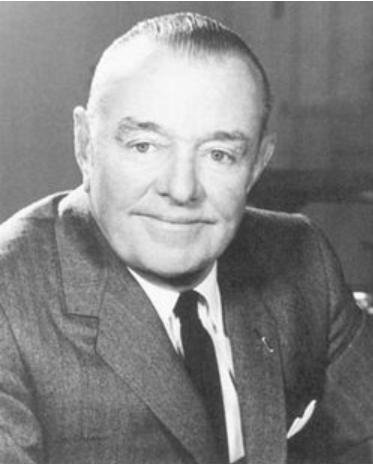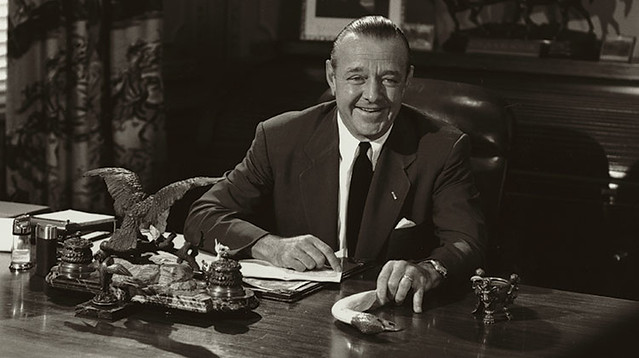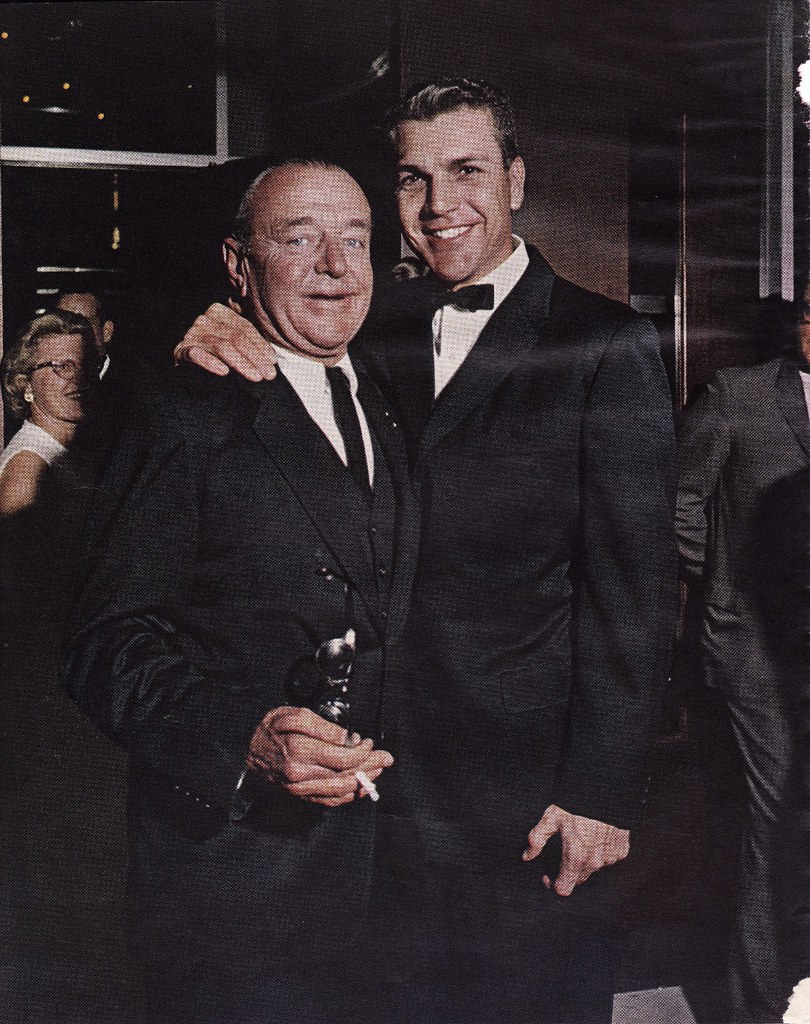
Today is the birthday of August Anheuser Busch, Jr., better known as Gussie Busch (March 28, 1899–September 29, 1989). He was the grandson of Anheuser-Busch founder Adolphus Busch. His parents were August Anheuser Busch, Sr. “Starting at lower levels to learn the family business of Anheuser-Busch Company, Busch became superintendent of brewing operations in 1924 and head of the brewing division after his father’s death in 1934. After his older brother Adolphus Busch III’s death in 1946, August A. Jr. succeeded him as President and CEO.”

Here’s a short biography from Find a Grave:
Born in St. Louis, Missouri, he was the President and CEO head of the Anheuser Busch Brewery the largest brewery in the world, (1946-75). He succeeded his older brother Adolphus bush III as President and CEO and began using the Bud Clydesdale Horse Team as a company logo. He was an avid sportsman and became owner of the National League St. Louis Cardinals Major League franchise in 1953, until his death. He died at age 90 in St. Louis, Missouri. In 1984, the Cardinals retired the number 85 in his honor, which was his age at the time and he was posthumously inducted into the Cardinals team Hall of Fame in 2014.

Gussie at his desk at Grant’s Farm.
This is August Anheuser Busch Jr.’s obituary from the New York Times:
August Anheuser Busch Jr., the master showman and irrepressible salesman who turned a small family operation into the world’s largest brewing company, died yesterday at his home in suburban St. Louis County, Mo. He was 90 years old and had recently been hospitalized with pneumonia.
August Anheuser Busch Jr., the master showman and irrepressible salesman who turned a small family operation into the world’s largest brewing company, died yesterday at his home in suburban St. Louis County, Mo. He was 90 years old and had recently been hospitalized with pneumonia.
He had been honorary chairman of the Anheuser-Busch Companies since his retirement in 1975. But he had remained active as the president of the St. Louis Cardinals, the National League baseball club he persuaded the company’s board to buy in 1953.
Mr. Busch, known as Gussie to virtually everybody who did not know him and as Gus to those who knew him well enough not to call him Mr. Busch, was the grandson and great-grandson of the founders of the company that bore two of his names.
The company, founded in 1876, survived Prohibition by moving into widely diverse products like soft drinks and automobile bodies.
Born in St. Louis on March 28, 1899, Mr. Busch entered the family business as a young man and became general superintendent of brewing operations in 1924. He took over as head of the brewery division after the death of his father in 1934. Although he did not become president of the company until the death of his older brother, Adolphus Busch 3d, in 1946, Mr. Busch had already made his mark as a salesman-showman.
To celebrate the repeal of Prohibition in 1933, Mr. Busch recalled the draft horses that had once pulled beer wagons in Germany and pre-automotive America and obtained a team to haul the first case of Budweiser down Pennsylvania Avenue for delivery to President Franklin D. Roosevelt at the White House. Since then the famous eight-horse hitch of Clydesdales has become almost as famous as the brand they continue to promote.
What was undoubtedly Mr. Busch’s greatest promotional coup was disguised as a civic duty – the company’s purchase of the Cardinals for $7.8 million in 1953 after the previous owner was convicted of income tax invasion.
”My ambition,” Mr. Busch declared, ”is, whether hell or high water, to get a championship baseball team for St. Louis before I die.”
He had a long wait. But beginning in 1964, the team won six National League pennants, most recently in 1987, and the World Series in 1964, 1967 and 1982.
Savored Success
Mr. Busch savored success, and he became a familiar triumphant figure to baseball fans in league playoffs and World Series home games when he would ride into Busch Stadium on the Clydesdale wagon waving a red cowboy hat.
He attributed the team’s success and the company’s to his policy of noninterference. Even so, he was active in the club’s affairs long after he left the company to others, and in 1982 he led the campaign among major league owners not to retain the previous commissioner, Bowie Kuhn.
Through the Clydesdales and the Cardinals, other promotional gimmicks and a commitment to mass advertising, Mr. Busch turned a comparatively small and financially ailing company into the industry giant. In his 29 years as the company’s active head, sales of beer went from 3 million to 37 million barrels a year. Last year the company produced 78.5 million barrels, almost double the output of its nearest competitor, and recorded sales of $9.7 billion. Its flagship brand, Budweiser, is the most popular beer in the world.
Medium Stature, Loud Voice
Through direct ownership and various trusts, Mr. Busch owned 12.5 percent of the company, or more than 30 million shares of its common stock. At yesterday’s closing price of $43.375 on the New York Stock Exchange, the holdings were worth more than $1.3 billion. The day’s increase of $1.125 a share represented a gain of more than $30 million. Trading in the company’s stock was suspended for 20 minutes after the announcement of his death.
Mr. Busch, at 5 feet 10 inches tall and 165 pounds, was a man of medium stature, but he had a loud voice that was once likened to the roar of a hoarse lion.
Fortunately for his colleagues, he had a sense of humor about his own shortcomings, which included a hairtrigger temper. ”All right, you guys,” he once shouted at a raucous company meeting. ”Let me blow my stack first. Then you can blow yours.” He also had an outsized zest for life, and both the wealth and the inclination to indulge it.
Among other things, his 281-acre estate, Grant’s Farm, includes a cabin built by hand by President Ulysses S. Grant and has a 34-room French Renaissance chateau and a well-stocked private zoo, which reflect his abiding love of animals. Mr. Busch trained his own chimpanzees and elephants before donating them to the St. Louis Zoo.
A onetime rodeo rider who later served as master of the Bridlespur Hunt outside St. Louis, Mr. Busch stocked his air-conditioned stables with several breeds, including hackneys, hunters and jumpers.
He clattered his way into family legend one day when he rode one of his horses up the main staircase of the family residence to cheer up his bedridden father.
Mr. Busch was married four times. Two of the marriages ended in divorce. His last wife, the former Margaret Rohde, died last year.

August A. Busch (center) and his sons, Adolphus III (left) and August Jr., seal the first case of beer off the Anheuser-Busch bottling plant line in St. Louis on April 7, 1933, when the sale of low-alcohol beers and wines was once again legal. Prohibition didn’t officially end until Dec. 5 of that year.
During World War II, Busch was very involved in the war effort through the Ordnance Corps, during which time he attained the rank of colonel.
Colonel August A. Busch, Jr. was born in 1899 in St. Louis, Missouri and was educated in the public schools there. He entered the family brewing business in 1924, and by 1931 was Second Vice President and a member of the board of directors. In June 1942, he was commissioned a major in the Ordnance Corps and was assigned to the Ammunition Division in the Office of the Chief of Ordnance.
He later became Deputy Chairman in charge of the Industry Integrating Committees of Ammunition (one of 82 committees set up to work with industry). Each Industry Integration Committee was made up of representatives from each participating contractor and set up to integrate Ordnance with industry. As Deputy Chairman, he was instrumental in expediting and improving production on several items. In January 1943, he was assigned to the Tank and Automotive Center at Detroit, Michigan. His task was to further the efforts of the committees on the production of tanks, the most critical item of Ordnance procurement. In March of 1943, he was reassigned to the Industry Committees of the Ammunition Division, as the Assistant Chief in Charge of Procurement for metal parts. In 1944, he became Chief of the Industry Production Branch while still retaining the title and duties of the Deputy Chairman of Industry Integrating Committees.
He established precedents and procedures that helped industry and Ordnance work together towards the war effort. His intimate knowledge of industry and his ability to gain the confidence of industrial leaders made him an invaluable asset to the Ordnance procurement process. During his later years, he served as Chairman of the board and Chief Executive Officer of Anheuser-Busch, Inc. and as Chairman of the board and President of the St. Louis Baseball Cardinals organization. Colonel Busch died in 1989.

The St. Louis Cardinals, which Anhesuer-Busch bought in 1953, became an important part of Gussie Busch’s life.
In 1953, Cardinals owner Fred Saigh was convicted of tax evasion. Facing almost certain banishment from baseball, he put the Cardinals up for sale. When Busch got word that Saigh was seriously considering selling the team to interests who would move the team to Houston; he decided to have Anheuser-Busch get into the bidding in order to keep the Cardinals in St. Louis. Ultimately, Busch persuaded Saigh to take less money ($3.75 million) than what he was being offered by out-of-town interests in the name of civic pride, and also achieved a marketing tool.
As chairman, president or CEO of the Cardinals from the time the club was purchased by the brewery in 1953 until his death, Busch oversaw a team that won six National League pennants (1964, 1967, 1968, 1982, 1985, 1987) and three World Series (1964, 1967 and 1982). When his son, August Busch III, ousted him as president of Anheuser-Busch, the elder Busch remained as president of the Cardinals.
Although the Cardinals were the dominant baseball team in St. Louis, they did not own their own ballpark. Since 1920 they had rented Sportsman’s Park from the St. Louis Browns of the American League. Shortly after buying the Cardinals, Busch bought and extensively renovated the park, renaming it Busch Stadium (but only after a failed attempt to rename it as Budweiser Stadium). The team played there until Busch Memorial Stadium was built in the middle of the 1966 season.
In 1984, the Cardinals retired a number, 85, in Busch’s honor, which was his age at the time.

Cardinal’s Owner and beer baron Gussie Busch threw a party at the Chase Hotel following the Cardinals 1964 World Series Championship. Here he congratulates Cardinal’s third baseman Ken Boyer, who hit two home runs and drove in six.
The Busch family also acquired Grant’s Farm, and made it the Busch Family Estate, opening it up to the public beginning in 1954. The estate website also has a timeline and there’s a short history of the farm from Wikipedia:
The property was at one time owned by Ulysses S. Grant and prior to that, by the Dent family. It is now owned by the Busch family, who owned the Anheuser-Busch Brewing Company for many years until it was sold to InBev in 2008. Grant’s Farm has been an animal reserve for many years and is open to the public for free; however, there is a parking fee of $12 per vehicle. This fee helps to maintain the farm. The farm is home to such animals as buffalo, elephants, camels, kangaroos, donkeys, goats, peacocks, the iconic Budweiser Clydesdales and many more. Most of these animals can be seen by visitors on a tram tour of the deer park region of the park, while the Clydesdales are found in their nearby barn and pastures. The farm also contains a cabin called “Hardscrabble,” which was built by Ulysses S. Grant on another part of the property and later relocated to Grant’s Farm. It is the only remaining structure that was hand-built by a U.S. president prior to assuming office.
Also on the farm is the Busch family mansion, and a house in which Ulysses S. Grant resided between the Mexican and Civil Wars—White Haven. This had been his wife, Julia Grant’s, family home. Frederick Dent, Julia’s father, gave 80 acres of the farm to the couple as a wedding present. White Haven is now a national historic site: the Ulysses S. Grant National Historic Site, and is located just across the road from Grant’s Farm.

Here’s Gussie’s entry from the Encyclopedia Britannica:
August Anheuser Busch, Jr., byname Gussie Busch (born March 28, 1899, St. Louis, Missouri, U.S. — died September 29, 1989, near St. Louis), American beer baron, president (1946–75) of Anheuser-Busch Companies, Inc., who built the company into the world’s largest brewery.
In 1922 Busch was put to work sweeping floors and cleaning vats at the brewery cofounded by his grandfather Adolphus Busch, but by 1924 he was general superintendent of brewing operations. After his father died (1934), Busch became head of the brewery department, and he was installed as president of the company following his older brother’s death (1946).
Busch was a civic leader who helped revive St. Louis in the 1950s by donating $5 million toward the construction of Busch Memorial Stadium and purchasing the St. Louis Cardinals professional baseball team for $7.8 million. A familiar figure during postseason play-off games, Busch often rode into the stadium in a wagon drawn by Clydesdales, the horses that were indelibly identified with the beer wagons of Budweiser, Anheuser-Busch’s main brand. Grant’s Farm, the Busch family estate near St. Louis, was converted into a 281-acre (114-hectare) historical site and wildlife preserve.

And finally, here’s a video created for Gussie’s induction into the St. Louis Sports Hall of Fame.
 To celebrate production of the ten millionth barrel of beer, August A. Busch Jr. (right) and his son August III share a toast with other officials of the company on December 15, 1964.
To celebrate production of the ten millionth barrel of beer, August A. Busch Jr. (right) and his son August III share a toast with other officials of the company on December 15, 1964.
No Harry Caray in any of those photos – damn! 🙂